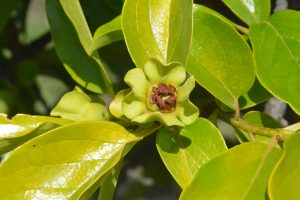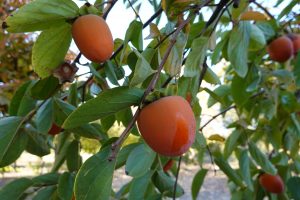Persimmon Collection
Jenny Smith, USDA-ARS National Clonal Germplasm Repository, One Shields Drive, University of California, Davis, California 95616
Gayle M. Volk, USDA-ARS National Laboratory for Genetic Resources Preservation, 1111 S. Mason St., Fort Collins, Colorado, 80521
John E. Preece, USDA-ARS National Clonal Germplasm Repository, One Shields Drive, University of California, Davis, California 95616
Outline
1. Introduction
Asian persimmons (Diospyros kaki) are the most commonly consumed type of persimmon, although there are many regional fruit types across the native distribution of the genus Diospyros. The 67 species of Diospyros are distributed in Africa, temperate Asia, tropical Asia, the Americas, and the Pacific Islands (Volk 2019). There were 3,800 acres of persimmons in production in the U.S. in 2017, with about 75% of the production in California (USDA NASS 2020).
Persimmons are usually consumed fresh, dried, or cooked. The most common non-astringent cultivar is ‘Fuyu’, which can be eaten fresh in either a firm or softened state. Astringent types of persimmons, such as ‘Hachiya’, are not consumed until they are very soft and have lost their astringency.
2. diospyrus (persimmon) collection
The U.S. National Plant Germplasm System persimmon collection has 159 accessions representing nine taxa that are maintained as trees in the field.
Figure 1. Persimmon branch (left) and trees (right) in the U.S. National Plant Germplasm System. Photo credit: Gayle Volk.
Figure 2. Persimmon flower. Photo credit: Gayle Volk.
Figure 3. Persimmon cultivars in the U.S. National Plant Germplasm System that are similar to the cultivar “Fuyu”. Photo credit: Gayle Volk.
Figure 4. Persimmon cultivars in the U.S. National Plant Germplasm System that are similar to the cultivar “Hachiya”. Photo credit: Gayle Volk.
Figure 5. Diversity of persimmon fruit. Photo credit: Gayle Volk.
Video 1. Dr. John Preece discusses the persimmon collection.
3. references
USDA National Agricultural Statistics Service (NASS). 2020. Noncitrus Fruits and Nuts 2019 Summary.
4. additional information
Curator: Jenny Smith, USDA-ARS National Clonal Germplasm Repository, One Shields Drive, University of California, Davis, CA 95616-8607, jenny.smith@usda.gov
5. Acknowledgments
Citation: Smith J, Volk GM, Preece JE. 2021. Persimmon collection. In: Volk GM, Preece JE (Ed.) Field tour of the USDA National Clonal Germplasm Repository for Tree Fruit, Nut Crops, and Grapes in Davis, California. Fort Collins, Colorado: Colorado State University. Date accessed. Available from: https://colostate.pressbooks.pub/davisrepositoryfieldtour/chapter/persimmons/
This training module was made possible in part by funding from USDA-ARS, Colorado State University, and the United States Agency for International Development (USAID).
Editors: Emma Balunek, Gayle Volk, Katheryn Chen
This project was funded in part by the National Academy of Sciences (NAS) and USAID, and any opinions, findings, conclusions, or recommendations expressed in such are those of the authors alone, and do not necessarily reflect the views of USAID or NAS. USDA is an equal opportunity provider and employer. Mention of trade names or commercial products in this article is solely for the purpose of providing specific information and does not imply recommendation or endorsement by the US Department of Agriculture.







